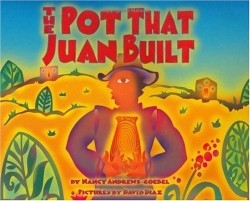
La Vasija Que Juan Fabric
Bringing the tale of Mexico’s master potter to young readers, this intoxicating translation will delight the mind, the eye, and the ear of the young reader. While on a trip to Mata Ortiz, the author met Juan Quezada and learned of how he turned the small faltering town into a robust artists’ community by discovering, developing, and sharing the Casas Grandes Indians’ technique for making pottery. The potter so impressed the author that she felt compelled to first co-produce a documentary about his art, “Mata Ortiz Pottery: An Inside Look,” and then write this, her first book.
Through years of experimentation and practice, Quezada, a self-taught potter, has achieved world renown for his art. One of his pots was even given to Pope John Paul II as a gift from the Mexican people. His is a story of artistic integrity and curiosity, and the need to preserve one’s community and culture. The Pot that Juan Built, first published in English in 2002, has won numerous awards, including the American Library Association’s Notable Children’s Book in 2003. Andrews-Goebel, a substitute teacher, is a member of the National Association for the Education of Young Children.
Modeled after the poem-chant structure of “The House That Jack Built,” the story builds a sense of anticipation in the reader, which, when coupled with the naturally rich rhythms and sounds of Spanish, reads like a song. For example, when describing the fire where the pots are cooked the lines read, “Son estas las llamas que nunca están fijas / que crepitan, titilan y cuecen la vasija / la hermosa vasija que Juan fabricó.” As the rhyme builds, each new concept is developed through a prose section that explains how Juan makes his pots. The epilogue covers the back story and impact of Quezada’s art, and includes photos of him at work.
Not only are the story important and interesting, and both the storytelling and translation flawless, but the illustrations are simply fantastic. The illustrator won the Caldecott Medal for his work on Smoky Night. For this book, he has created a stylized world of luminous images that feel like memories of a dream. Though created by computer, the jewel tone figures seem airbrushed onto stone, their feathery graininess evoking the arid landscape of Mata Ortiz. The line of the figures, such as the medallion suns, also mirrors the decorations on Quezada’s pots.
The publisher suggests a reading level of second to third grade, but a good picture book such as this is ageless. It is an excellent example of what a children’s book should be: educational, entertaining, memorable, socially conscious, and beautifully executed. It is no wonder its list of awards only continues to grow.
Disclosure: This article is not an endorsement, but a review. The publisher of this book provided free copies of the book to have their book reviewed by a professional reviewer. No fee was paid by the publisher for this review. Foreword Reviews only recommends books that we love. Foreword Magazine, Inc. is disclosing this in accordance with the Federal Trade Commission’s 16 CFR, Part 255.
